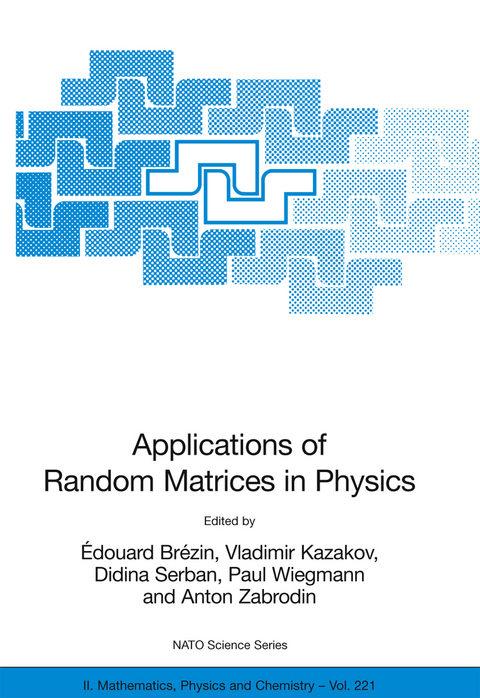
Applications of Random Matrices in Physics
Springer-Verlag New York Inc.
978-1-4020-4529-5 (ISBN)
Preface.- Random Matrices and Number Theory. 1. Introduction. 2. () 3. Characteristic polynomials of random unitary matrices 4. Other compact groups. 5. Families of L-functions and Symmetry. 6. Asymptotic expansions. References.- 2D Quantum Gravity, Matrix Models and Graph Combinatorics. 1. Introduction. 2. Matrix models for 2D quantum gravity. The one-matrix model I: large N limit and the enumeration of planar graphs. 4. The trees behind the graphs. 5. The one-matrix model II: topological expansions and quantum gravity. 6. The combinatorics beyond matrix models: geodesic distance in planar graphs. 7. Planar graphs as spatial branching processes. 8. Conclusion.- Eigenvalue Dynamics, Follytons and Large N Limits of Matrices. References.- Random Matrices and Supersymmetry in Disordered Systems. Supersymmetry method. 2. Wave functions fluctuations in a finite volume. Multifractality. Recent and possible future developments. Summary. Acknowledgements. References.- Hydrodynamics of Correlated Systems. 1. Introduction. 2. Instanton or rare fluctuation method. 3. Hydrodynamic approach. 4. Linearized hydrodynamics or bosonization. 5. EFP through an asymptotics of the solution. 6. Free fermions. 7. Calogero-Sutherland model. 8. Free fermions on the lattice. 9. Conclusion. Acknowledgements. Appendix: Hydrodynamic approach to non-Galilean invariant systems. Appendix: Exact results for EFP in some integrable models. References.- QCD, Chiral Random Matrix Theory and Integrability. 1. Summary. 2. Introduction. 3. QCD. 4. The Dirac Spectrum in QCD. 5. Low Energy Limit of QCD. 6. Chiral RMT and the QCD Dirac Spectrum. 7. Integrability and the QCD Partition Function. 8. QCD at Finite Baryon Density. 9. Full QCD at Nonzero Chemical Potential. 10. Conclusions. Acknowledgements. References.- Euclidan Random Matrices: Solved and Open Problems. 1. Introduction. 2. Basic definitions. 3. Physical motivations. 4. Field theory. 5. The simplest case. 6. Phonnos. References.- Matrix Modelsand Growth Processes. 1. Introduction. 2. Some ensembles of random matrices with complex eigenvalues. 3. Exact results at finite N. 4. Large N limit. 5. The matrix model as a growth problem. References.- Matrix Models and Topological Strings. 1. Introduction. 2. Matrix models. 3. Type B topological strings and matrix models. 4. Type A topological strings, Chern-Simons theory and matrix models.- Matrix Models of Moduli Space. 1. Introduction. 2. Moduli Space of Riemann Surfaces and its Topology. 3. Quadratic Differentials and Fatgraphs. 4. The Penner model. 5. Penner Model and Matrix Gamma Function. 6. The Kontsevich Model. 7. Applications to String Theory. 8. Conclusions. References.- Matrix Models and 2D String Theory. 1. Introduction. 2. An overview of string theory. 3. Strings in D-dimensional spacetime. 4. Discretized surfaces and 2D string theory. 5. An overview of observables. 6. Sample calculation: the disk one-point function. 7. Worldsheet description of matrix eigenvalues. 8. Further results. 9. Open problems. References.- Matrix Models as Conformal Field Theories. 1. Introduction and historical notes. 2. Hermitian matrix integral: saddle points and hyperellptic curves. 3. The hermitian matrix model as a chiral CFT. 4. Quasiclassical expansions: CFT on a hyperelliptic Riemann surface. 5. Generalization to chains of random matrices. References.-
| Erscheint lt. Verlag | 13.3.2006 |
|---|---|
| Reihe/Serie | NATO Science Series II: Mathematics, Physics and Chemistry ; 221 |
| Zusatzinfo | X, 510 p. |
| Verlagsort | New York, NY |
| Sprache | englisch |
| Maße | 155 x 235 mm |
| Themenwelt | Naturwissenschaften ► Physik / Astronomie ► Allgemeines / Lexika |
| Naturwissenschaften ► Physik / Astronomie ► Theoretische Physik | |
| ISBN-10 | 1-4020-4529-8 / 1402045298 |
| ISBN-13 | 978-1-4020-4529-5 / 9781402045295 |
| Zustand | Neuware |
| Haben Sie eine Frage zum Produkt? |
aus dem Bereich


